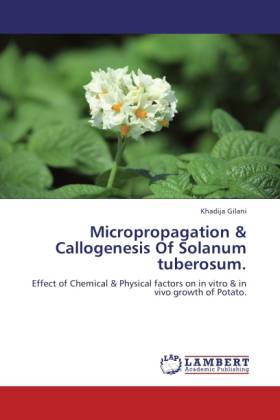
- Afhalen na 1 uur in een winkel met voorraad
- Gratis thuislevering in België vanaf € 30
- Ruim aanbod met 7 miljoen producten
- Afhalen na 1 uur in een winkel met voorraad
- Gratis thuislevering in België vanaf € 30
- Ruim aanbod met 7 miljoen producten
Zoeken
Micropropagation & Callogenesis Of Solanum tuberosum.
Effect of Chemical & Physical factors on in vitro & in vivo growth of Potato.
Khadija Gilani
Paperback | Engels
€ 65,45
+ 130 punten
Omschrijving
The given plant, Solanum tuberosum was grown in the field as well as in petri plants by seeds.The different explants such as leaf, node, internodes, bud and roots were taken for micropropagation. These explants were grown in vitro after thorough sterilization using different PGR in different media composition.The PGR used were 2,4-D, BAP and NAA. Their combination were also used i.e. 2,4-D+BAP, BAP+NAA and 2,4-D+NAA in different concentration.The most effective and suitable media composition was MS (Murashige & Skoog, 1962) basal medium with BAP (2.0 mg/l) for regeneration from nodal explant of Solanum tuberosum.The optimum temperature was found to be 23± 02 oC. The micropropagation occurred more precisely at about 30 (g/l) sucrose concentrations. The most effective photoperiod for the regeneration of Solanum tuberosum was 16 hours light period. The pH 5.7 was considered to be the best for the micropropagation of Solanum tuberosum.
Specificaties
Betrokkenen
- Auteur(s):
- Uitgeverij:
Inhoud
- Aantal bladzijden:
- 108
- Taal:
- Engels
Eigenschappen
- Productcode (EAN):
- 9783848419333
- Verschijningsdatum:
- 1/03/2012
- Uitvoering:
- Paperback
- Afmetingen:
- 150 mm x 220 mm
- Gewicht:
- 160 g

Alleen bij Standaard Boekhandel
+ 130 punten op je klantenkaart van Standaard Boekhandel
Beoordelingen
We publiceren alleen reviews die voldoen aan de voorwaarden voor reviews. Bekijk onze voorwaarden voor reviews.








